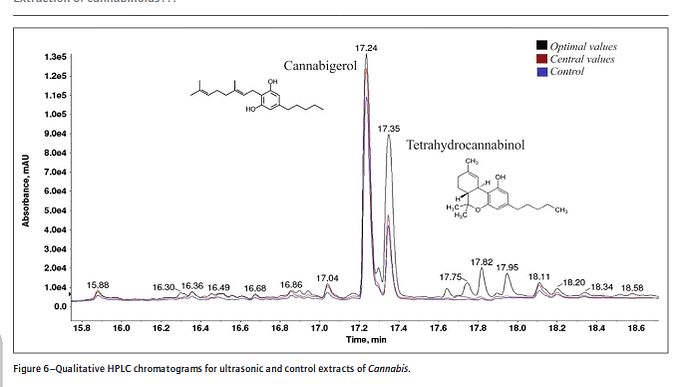I want to extract rosmaranic acid from dried spearmint. The preferred method is to do an ultrasonic extraction in ethanol/water. The method I read used 20khz/300 watts. The proper ultrasonic extaction probes are too expensive for me, but ultrasonic cleaning baths are cheap. I believe the ultrasound needs to be powerful enough to rupture the plant cells to release the rosmaranic acid.
Try it. What do you have to lose? Some biomass and a little time?!?
Cannabis does NOT benefit from such treatment, so looking around here for data isn’t likely to yield well.
Huh Huh hmmm😀
I have had a couple different customers try ultrasonic extraction and both have ceased doing it. However, they were attempting to extract cannabinoids from hemp so they had a different outcome in mind. If your goal is to purposely blast open the leafy green plant cells then yes it works swimmingly well.
Yes that is my goal to break open cells, to release chemicals in the cells. Just wondering if an ultrasonic cleaning bath is as effective as an ultrasonic probe.
again, what do you have to lose by trying it?
AND
it doesn’t work well for cannabis, so nobody in their right mind would have collated data on the relative efficacy of those two…they both suck for cannabis!
My apologies, but that’s not accurate. If you’d like a published and peer reviewed paper on ultrasonic extraction of cannabinoids, [Spoiler: 2x the extraction in 1/2 the time] DM me.
if you’ve got a published peer reviewed paper, then drop it in the data dump and put a link where we can all see it.
2x the speed and 10X the junk
I’m not sure of the legality of making it publicly available by posting it here. I don’t mind sharing it individually though.
posting a link to the paywalled version is certainly legit.
those that want to go get it can then do so.
https://scholar.google.com/scholar?q=ultrasonic+cannabinoid+extraction
or just point out which of these it is…if it is
thanks! got it!!
others can got grab it via https://sci-hub.se
I had Plandai biotechnology try and convince me to invest in their tech 5 years ago. their tech works great for cytosolic compounds. actually isomerized THC/CBD…so they were screaming too loud…
i was just about to link it. For the lazy https://twin.sci-hub.tw/6664/c21b5be302905bc683a224e62dc9025a/agarwal2018.pdf
improved extraction yield obtained at higher ultrasonic power is due to the enhanced physical effects such as cracked cell walls…
unclear to me which cell walls need cracked to get at the cannabinoids…
I apologize if this is all known, but for anyone who doesn’t, here’s the gist of how this works. Ultrasonic waves create microscopic boiling points within a fluid. These bubbles exist for fractions of a second but attain astounding temperatures and pressures before collapsing. As the bubble collapses, it accelerates a small amount of solvent at an incredibly high velocity. When this interacts with trichomes it causes them to become dislodged from the surface of the material. However, it goes a step further. Ultrasonics are also used in cell disruption. The vibrations cause this same boiling to occur in the fluid trapped within the plant cell structure. When this boiling occurs inside a cell, it causes the cell to rupture. This leads to an increase in the amount of material extracted from the biomass. Unfortunately, I have not been able to find ultrasonics capable operating at subcooled temperatures, likely due to brittle fracture, so the result is an extract high in chlorophyll and lipids, requiring winterization. Ultrasonics are also a method of developing water soluble oils, so with the proper R&D it could be possible to produce an extraction process that results in high efficiency and water solubility. I’ve also explored the idea of submersing the transducer in a separate heat circulated vessel, likely distilled water, but I’m not enough of an expert to know the transmission rate through the stainless to the surrounding extraction solvent. I do however think its possible. Titanium ultrasonic rod transducers are my current favorite method, as they eliminate the overlaps and dead spots associated with tank mounted transducers. The trade of is that they require immersion.
Sorry for the wall of text, just a topic i’m highly interested in. If i mispoke, or am flat out wrong on anything, don’t hesitate to correct me. I hate inadvertently providing inaccurate information.
I can’t confirm, but my thought was that it ruptures the trichomes themselves.
looks like more “junk” to me…might be useful bioactives.
might be poisonous.
can’t tell from provided data
Edit: I know for a fact that what they call “junk DNA” is not. Got my PhD on that premise…
Thanks for looking the paper over, I’m definitely not a PhD, so it’s nice to get an expert opinion on this.
I made a post about filling a bath up with ball bearing as using it to dewax… still. Crazy idea?

